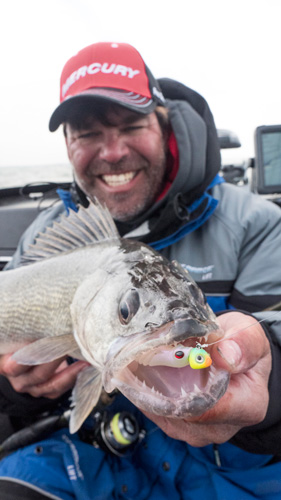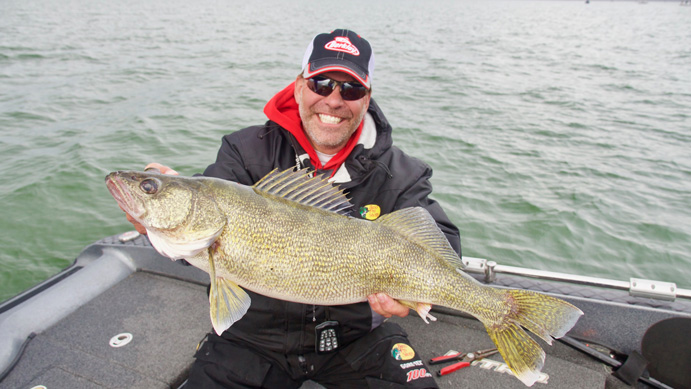Move Out To Jig Pigs
By Gary Parsons and Keith Kavajecz
If you’d like to catch big walleyes, (and don’t live near Lake Erie) and are bummed out because the walleyes just finished spawning and you think the bite is going to stink, you need to keep reading!
For years, a belief in the walleye world was that after fish spawned in the spring the larger fish wouldn’t bite right away. Over time we have found out that that isn’t necessarily the case. One of the things that seem to be common when looking for these early bites, is that walleyes tend to be feeding in areas near the areas where they just finished spawning. We are used to fishing shallow, and normally can catch the smaller males, but where are all of the bigger females? Well, you will need to look at spawning areas where rocks and gravel extend out into deeper water. The females seem to like these areas that are 15-35 feet deep…yes, that deep, even early in the year!
The fish can be pretty lethargic at this time, and they like to hide tight to bottom in the rocks. The water at this time is less than 50 degrees, so crawler harnesses won’t be effective and even the slowest trolling of Crankbaits usually won’t solicit a bite.
This is the time to bring out the jigs. We like to tie on a 1/4oz – 3/8oz long shank Bass Pro Shops XPS or a Mustad WL Elite Series jig. Strike King, Berkley, or Mustad Darter heads can also work.
 The key is the artificial bait you put on the jig. We like to use a 4-inch Berkley GULP! Minnows or Powerbait minnows that are 4-5 inches long. While you might think that the best way to work the jig is to crawl it across bottom, you actually will not want do this. Instead, jig it fairly aggressively. Either cast it out and work it back in or slowly rip jig it way behind the boat in a slow electric motor troll using 2-3 foot sweeps. It is insane how many fish will bite, and on a lake like Green Bay, the fish will be big too! This is a great time of year to catch giant fish.
The key is the artificial bait you put on the jig. We like to use a 4-inch Berkley GULP! Minnows or Powerbait minnows that are 4-5 inches long. While you might think that the best way to work the jig is to crawl it across bottom, you actually will not want do this. Instead, jig it fairly aggressively. Either cast it out and work it back in or slowly rip jig it way behind the boat in a slow electric motor troll using 2-3 foot sweeps. It is insane how many fish will bite, and on a lake like Green Bay, the fish will be big too! This is a great time of year to catch giant fish.
As the water warms you’ll want to switch to different types of tails. Many walleye fishermen have taken a lesson from the bass guys by using a smallmouth bedding bite technique with hair jigs. With a small black or purple 1/4oz hair jig, cast beyond where you think the fish might be and let the jig free fall to the bottom. Once the jig hits bottom, slowly crank it two times and then let it fall back to bottom. Once it hits bottom, crank it again two times. Point the rod to the jig or at a slight angle to do a semi-swim back to the boat. While hair jigs have been here forever, this technique is new and deadly effective down to 30 feet.
The last technique you want to try is working a 3/8oz or 1/2oz jig with a 3.5 to 5 inch Berkley Ripple Shad. When you take the Ripple Shad out of the package, stretch it out, like limbering a rubber band. By doing this, the bait will swim two to three times more effectively. This is important as the tail will swim much more natural and elicit more bites.
Just like the hair jig, you will want to cast it out, then give a couple of turns on the reel. Visualize the bait swimming along the bottom. Let it sit for a second and then reel again. It is amazing how hard the fish will hit! The cool thing about this technique is that it also becomes deadly in late fall. In many cases you will catch fish in the same types of places as the spring bite, in addition to the typical sunken island and steep breaking shoreline fall hotspots where live minnows are usually used. We have absolutely crushed big fish with this technique.
For gear, we like to use a conventional jigging rod like the 6’ or 6’6” medium light Walleye Angler rod with a fast taper. For line we use 10lb Berkley NanoFil or FireLine and 10lb 100 percent Fluorocarbon leaders tied directly to jigs.
 The neat thing about this type of fishing is that you can often see the fish on your electronics before you even put a line in the water. If you see one or two just off bottom, you can assume there are several more there, as they usually hang tight to bottom (hiding in between the rocks) this time of year. This is where the use of a Lowrance HDS is important. Using 2D sonar and side scanning modes will help you locate the deep rock and fishy looking spots. If you see an interesting area, switch to downscan, to see if some of those marks have separation from the bottom, assuring you that they are fish.
The neat thing about this type of fishing is that you can often see the fish on your electronics before you even put a line in the water. If you see one or two just off bottom, you can assume there are several more there, as they usually hang tight to bottom (hiding in between the rocks) this time of year. This is where the use of a Lowrance HDS is important. Using 2D sonar and side scanning modes will help you locate the deep rock and fishy looking spots. If you see an interesting area, switch to downscan, to see if some of those marks have separation from the bottom, assuring you that they are fish.
When fishing a good looking area you are searching for that first bite, and if you get it make sure that you put your trolling motor into anchor mode (we use a MotorGuide Xi5 trolling motor for this) and begin to work the area thoroughly. This is also when a HydroWave works well. Start with the “passive bait” mode sound and experiment from there to see if you get more bites. Some days it really makes a difference! If you are in an area where you’re catching fish, don’t go far to find the next one. This isn’t a fast and furious bite. On a good day you might only catch ten fish, but they will be quality fish. This is a very fun bite that we look forward to each year. Give it a shot and we think you too will be hooked on jigging up your Next Bite!










